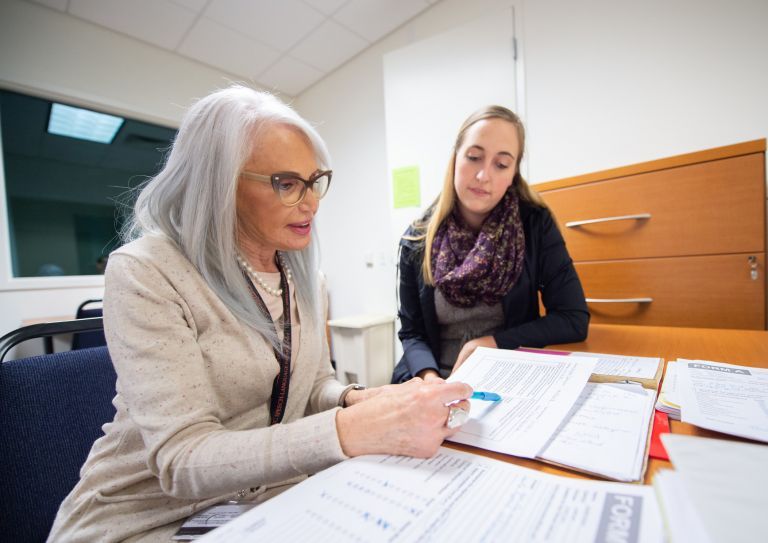Job opportunities following graduation can be found at AfterCollege Careers.
The following information has been taken from the American Speech-Language Hearing Association website.
Nature of the Work
Working with the full range of human communication and its disorders, speech-language pathologists:
- Evaluate and diagnose speech, language, cognitive-communication and swallowing disorders.
- Treat speech, language, cognitive-communication and swallowing disorders in individuals of all ages, from infants to the elderly.
In addition, speech-language pathologists may:
- Teach in college and university programs.
- Manage agencies, clinics, organizations, or private practices.
- Engage in research to enhance knowledge about human communication processes.
- Supervise and direct public school or clinical programs
- Develop new methods and products to evaluate and treat speech-language disorders.
Speech-language pathologists often work as part of a team, which may include teachers, physicians, audiologists, psychologists, social workers, rehabilitation counselors and others. Corporate speech-language pathologists also work with employees to improve communication with their customers.
Work Sites
The practice and work of speech-language pathologists may take place in various settings:
- Public and private schools
- Hospitals
- Rehabilitation centers
- Short-term and long-term nursing care facilities
- Community clinics
- Colleges and universities
- Private practice offices
- State and local health departments
- State and federal government agencies
- Home health agencies (home care)
- Long-term care facilities
- Adult day care centers
- Centers for persons with developmental disabilities
- Research laboratories
Pacific graduates typically begin their employment in either public schools (50%) or medical centers (50%). A major advantage to the Pacific program is that graduates are prepared to work competently with either children in a school setting or adults in a medical setting. 100% of Pacific graduates receive employment offers in the field, usually weeks before they graduate.
Earnings
Salaries of speech-language pathologists depend on their educational background, specialty and experience, along with the geographical location and type of setting in which they work. According to the 2018 Bureau of Labor Statistics, salaries ranged from $72,000 to 94,800. Good benefits packages, such as insurance programs and leave, are usually available to these professionals.
Working Conditions
Because there is such a wide variety of employment settings, working conditions also vary. Facilities in most school systems and established clinics are comfortable and adequately equipped, as are most facilities for research, colleges, and private practice. Since speech and hearing services are a vital part of total health care and the educational system, the number of work sites is constantly expanding. Because of the increasing demand for these services, work schedules may be heavy. An additional challenge is the constant need to update knowledge through educational experiences and reading periodicals. These challenges are balanced by the satisfaction of contributing to the quality of life of adults and children through facilitating the vital need of persons to communicate effectively.
Size of the Profession
The American Speech-Language Hearing Association (ASHA) represents over 198,000 professionals. There are 168,604 ASHA- certified speech language pathologists. Also, there are 849 persons who hold dual ASHA certification. That is, they are certified as both audiologists and speech-language pathologists. These individuals hold many major positions in clinical, academic and research fields.
Future Outlook
According to the U.S. Bureau of Labor Statistics, employment in speech-language pathology is expected to grow 18% from 2016-2026, considerably faster than the average occupation growth rate of 7%. With the increased life expectancy of Americans, the possibility of neurological disorders and associated speech, language, swallowing, and hearing impairments also increases. Medical advances are also improving the survival rate of premature infants and trauma and stroke survivors, who then need assessment and possible treatment. All states now require that all newborns be screened for hearing loss and receive appropriate early intervention services.
Employment in educational services will increase along with growth in elementary and secondary school enrollments, including enrollment of special education students. Federal law guarantees special education and related services to all eligible children with disabilities. Greater awareness of the importance of early identification and diagnosis of speech, language, swallowing, and hearing disorders will also increase employment.
The number of speech-language pathologists in private practice will rise due to the increasing use of contract services by hospitals, schools, and nursing care facilities. In addition to job openings stemming from employment growth, a number of openings for speech-language pathologists will arise from the need to replace those who leave the occupation.




